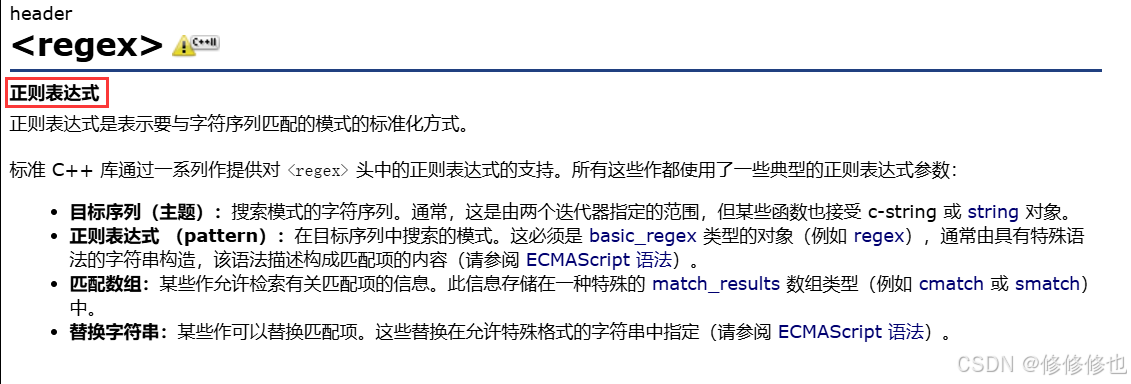【网络编程】正则表达式快速上手指南
【网络编程】正则表达式快速上手指南

正则表达式(Regular Expression)详解
正则表达式(简称 Regex 或 RegExp)是一种文本模式匹配工具,用于在字符串中搜索、替换、提取符合特定规则的文本片段。它的语法简洁但功能强大,广泛应用于编程、文本编辑、日志分析等领域。 C++11官方文档中对正则表达式的介绍如下:

一、核心概念
1. 基本用途
- 验证:检查字符串是否符合规则(如邮箱、电话号码格式)。
- 搜索:快速定位特定模式的文本。
- 替换:批量修改符合模式的文本。
- 提取:从文本中抽取结构化数据。
2. 语法组成
- 普通字符:直接匹配字符本身(如
a匹配字母a)。 - 元字符:具有特殊含义的符号(如
.、*、^)。 - 字符类:匹配一组字符中的任意一个(如
[abc])。 - 量词:控制匹配次数(如
+、?、{n,m})。 - 分组与捕获:用
()定义子表达式并捕获内容。
二、基础语法
1. 元字符(Meta Characters)
元字符 | 描述 | 示例 |
|---|---|---|
. | 匹配除换行符(\n、\r)之外的任何单个字符。要匹配包括 '\n' 在内的任何字符,请使用像"(.|\n)"的模式。 | a.c→"abc"、"a3c" |
^ | 匹配输入字符串的开始位置。如果设置了 RegExp 对象的 Multiline 属性,^ 也匹配 '\n' 或 '\r' 之后的位置。 | ^Hello → "Hello World" 中的 "Hello" |
$ | 匹配输入字符串的结束位置。如果设置了RegExp 对象的 Multiline 属性,$ 也匹配 '\n' 或 '\r' 之前的位置。 | World$ → "Hello World" 中的 "World" |
\ | 将下一个字符标记为一个特殊字符、或一个原义字符、或一个 向后引用、或一个八进制转义符。 | \. → 匹配实际的 . 字符 |
[...] | 字符集合。匹配所包含的任意一个字符。 | [aeiou] → 匹配"plain"中的'a'和'i' |
2. 量词(Quantifiers)
量词 | 描述 | 示例 |
|---|---|---|
* | 匹配前一个元素 0 次或多次 | ab*c → "ac"、"abbc" |
| 匹配前一个元素 1 次或多次 | ab+c → "abc"、"abbc" |
? | 匹配前一个元素 0 次或 1 次 | colou?r → "color"、"colour" |
{n} | 匹配前一个元素恰好 n 次 | a{3} → "aaa" |
{n,} | 匹配前一个元素至少 n 次 | a{2,} → "aa"、"aaaa" |
{n,m} | 匹配前一个元素 n 到 m 次 | a{2,4} → "aa"、"aaaa" |
3. 字符类(Character Classes)
语法 | 描述 | 等价写法 |
|---|---|---|
\d | 匹配数字 | [0-9] |
\D | 匹配非数字 | [^0-9] |
\w | 匹配单词字符(字母、数字、下划线) | [a-zA-Z0-9_] |
\W | 匹配非单词字符 | [^a-zA-Z0-9_] |
\s | 匹配空白符(空格、制表符等) | [ \t\n\r\f\v] |
\S | 匹配非空白符 | [^ \t\n\r\f\v] |
三、进阶语法
1. 分组与捕获
普通分组:() 定义子表达式,并捕获匹配内容。
(\d{4})-(\d{2})-(\d{2}) # 匹配日期 "2023-10-01",捕获年、月、日非捕获分组:(?:...) 分组但不捕获。
(?:https?|ftp)://([^/]+) # 匹配 URL,但只捕获域名部分2. 贪婪匹配 vs 非贪婪匹配
贪婪模式(默认):尽可能匹配更长的文本。
<.*> # 匹配整个 "<div>content</div>" 字符串非贪婪模式:在量词后加 ?,匹配尽可能短的文本。
<.*?> # 匹配 "<div>" 和 "</div>" 两个标签3. 预查(Lookaround)
语法 | 描述 | 示例 |
|---|---|---|
(?=...) | 正向肯定预查(匹配后面是...的位置) | Windows(?=10)→ 匹配 "Windows10" 中的 "Windows" |
(?!...) | 正向否定预查(匹配后面不是...的位置) | \d{3}(?!\d) → 匹配三位数且后面没有数字 |
(?<=...) | 反向肯定预查(匹配前面是...的位置) | (?<=\$)\d+ → 匹配 "$100" 中的 "100" |
(?<!...) | 反向否定预查(匹配前面不是...的位置) | (?<!-)\d+ → 匹配非负整数 |
四、实际应用示例
1. 验证邮箱地址
^[a-zA-Z0-9._%+-]+@[a-zA-Z0-9.-]+\.[a-zA-Z]{2,}$- 分解:
-
^[a-zA-Z0-9._%+-]+:用户名部分(允许字母、数字、特殊符号)。 -
@[a-zA-Z0-9.-]+:域名部分(如gmail、example.co)。 -
\.[a-zA-Z]{2,}$:顶级域名(如.com、.org,至少两个字母)。
-
2. 提取 HTML 标签内容
<h1>(.*?)</h1> # 非贪婪匹配标签内容3. 匹配 IPv4 地址
^((25[0-5]|2[0-4]\d|[01]?\d\d?)\.){3}(25[0-5]|2[0-4]\d|[01]?\d\d?)$五、C++11正则库的使用
C++11 引入了
<regex>标准库,提供了对正则表达式的原生支持。以下是 C++11 正则表达式库的详细使用方法。C++官方文档连接:https://legacy.cplusplus.com/reference/regex/
1. 核心类和组件
类/组件描述
std::regex表示一个正则表达式对象,用于编译和存储正则模式。std::smatch存储字符串的匹配结果(如std::string的匹配结果)。std::ssub_match表示一个子匹配项(如捕获组的内容)。std::regex_match匹配整个字符串是否符合正则模式。std::regex_search在字符串中搜索符合正则模式的子串。std::regex_replace替换字符串中符合正则模式的部分。std::regex_iterator迭代器,用于遍历所有匹配项。std::regex_constants包含正则表达式选项的命名空间(如忽略大小写、多行模式等)。
2.基本用法示例
1. 正则表达式验证(regex_match)
#include <iostream>
#include <regex>
#include <string>
bool validate_email(const std::string &email) {
// 正则模式:用户名@域名.顶级域名
std::regex pattern(R"([a-zA-Z0-9._%+-]+@[a-zA-Z0-9.-]+\.[a-zA-Z]{2,})");
return std::regex_match(email, pattern);
}
int main() {
std::string email = "user@example.com";
if (validate_email(email)) {
std::cout << "Valid email!" << std::endl;
} else {
std::cout << "Invalid email!" << std::endl;
}
return 0;
}2. 搜索和提取数据(regex_search)
#include <iostream>
#include <regex>
#include <string>
void extract_date(const std::string &text) {
std::regex pattern(R"((\d{4})-(\d{2})-(\d{2}))"); // 匹配日期格式YYYY-MM-DD
std::smatch matches;
if (std::regex_search(text, matches, pattern)) {
std::cout << "Full match: " << matches[0] << std::endl;
std::cout << "Year: " << matches[1] << std::endl;
std::cout << "Month: " << matches[2] << std::endl;
std::cout << "Day: " << matches[3] << std::endl;
}
}
int main() {
std::string text = "Event date: 2023-10-05";
extract_date(text);
return 0;
}3. 替换文本(regex_replace)
#include <iostream>
#include <regex>
#include <string>
std::string mask_phone(const std::string &phone) {
// 将电话号码中间四位替换为****
std::regex pattern(R"((\d{3})(\d{4})(\d{4}))"); // 匹配11位手机号
return std::regex_replace(phone, pattern, "$1****$3");
}
int main() {
std::string phone = "13812345678";
std::cout << mask_phone(phone) << std::endl; // 输出: 138****5678
return 0;
}4. 遍历所有匹配项(regex_iterator)
#include <iostream>
#include <regex>
#include <string>
void find_all_urls(const std::string &text) {
std::regex pattern(R"((https?|ftp)://[^\s/$.?#].[^\s]*)");
auto begin = std::sregex_iterator(text.begin(), text.end(), pattern);
auto end = std::sregex_iterator();
for (std::sregex_iterator i = begin; i != end; ++i) {
std::smatch match = *i;
std::cout << "Found URL: " << match.str() << std::endl;
}
}
int main() {
std::string text = "Visit https://example.com or http://test.org";
find_all_urls(text);
return 0;
}3. 正则表达式语法选项
可以通过 std::regex_constants 中的标志调整正则行为:
标志 | 描述 |
|---|---|
std::regex::icase | 忽略大小写 |
std::regex::multiline | 多行模式(^ 和 $ 匹配行首行尾) |
std::regex::ECMAScript | 使用 ECMAScript 语法(默认) |
std::regex::extended | 使用 POSIX 扩展正则语法 |
示例:忽略大小写匹配
std::regex pattern("hello", std::regex::icase);
std::smatch matches;
std::regex_search("HELLO World", matches, pattern); // 匹配成功六、常用正则表达式
1.校验数字的表达式
- 数字:^[0-9]*$
- n位的数字:^\d{n}$
- 至少n位的数字:^\d{n,}$
- m-n位的数字:^\d{m,n}$
- 零和非零开头的数字:^(0|[1-9][0-9]*)$
- 非零开头的最多带两位小数的数字:^([1-9][0-9]*)+(\.[0-9]{1,2})?$
- 带1-2位小数的正数或负数:^(\-)?\d+(\.\d{1,2})$
- 正数、负数、和小数:^(\-|\+)?\d+(\.\d+)?$
- 有两位小数的正实数:^[0-9]+(\.[0-9]{2})?$
- 有1~3位小数的正实数:^[0-9]+(\.[0-9]{1,3})?$
- 非零的正整数:^[1-9]\d* 或 ^([1-9][0-9]*){1,3} 或 ^\+?[1-9][0-9]*
- 非零的负整数:^\-[1-9][]0-9"*
- 非负整数:^\d+ 或 ^[1-9]\d*|0
- 非正整数:^-[1-9]\d*|0 或 ^((-\d+)|(0+))
- 非负浮点数:^\d+(\.\d+)? 或 ^[1-9]\d*\.\d*|0\.\d*[1-9]\d*|0?\.0+|0
- 非正浮点数:^((-\d+(\.\d+)?)|(0+(\.0+)?)) 或 ^(-([1-9]\d*\.\d*|0\.\d*[1-9]\d*))|0?\.0+|0
- 正浮点数:^[1-9]\d*\.\d*|0\.\d*[1-9]\d* 或 ^(([0-9]+\.[0-9]*[1-9][0-9]*)|([0-9]*[1-9][0-9]*\.[0-9]+)|([0-9]*[1-9][0-9]*))
- 负浮点数:^-([1-9]\d*\.\d*|0\.\d*[1-9]\d*) 或 ^(-(([0-9]+\.[0-9]*[1-9][0-9]*)|([0-9]*[1-9][0-9]*\.[0-9]+)|([0-9]*[1-9][0-9]*)))
- 浮点数:^(-?\d+)(\.\d+)? 或 ^-?([1-9]\d*\.\d*|0\.\d*[1-9]\d*|0?\.0+|0)
2.校验字符的表达式
- 汉字:^[\u4e00-\u9fa5]{0,}$
- 英文和数字:^[A-Za-z0-9]+ 或 ^[A-Za-z0-9]{4,40}
- 长度为3-20的所有字符:^.{3,20}$
- 由26个英文字母组成的字符串:^[A-Za-z]+$
- 由26个大写英文字母组成的字符串:^[A-Z]+$
- 由26个小写英文字母组成的字符串:^[a-z]+$
- 由数字和26个英文字母组成的字符串:^[A-Za-z0-9]+$
- 由数字、26个英文字母或者下划线组成的字符串:^\w+ 或 ^\w{3,20}
- 中文、英文、数字包括下划线:^[\u4E00-\u9FA5A-Za-z0-9_]+$
- 中文、英文、数字但不包括下划线等符号:^[\u4E00-\u9FA5A-Za-z0-9]+ 或 ^[\u4E00-\u9FA5A-Za-z0-9]{2,20}
- 可以输入含有^%&',;=?
- 禁止输入含有~的字符:[^~]+
3.特殊需求表达式
- Email地址:^\w+([-+.]\w+)*@\w+([-.]\w+)*\.\w+([-.]\w+)*$
- 域名:[a-zA-Z0-9][-a-zA-Z0-9]{0,62}(\.[a-zA-Z0-9][-a-zA-Z0-9]{0,62})+\.?
- InternetURL:[a-zA-z]+://[^\s]* 或 ^http://([\w-]+\.)+[\w-]+(/[\w-./?%&=]*)?$
- 手机号码:^(13[0-9]|14[01456879]|15[0-35-9]|16[2567]|17[0-8]|18[0-9]|19[0-35-9])\d{8}$
- 电话号码("XXX-XXXXXXX"、"XXXX-XXXXXXXX"、"XXX-XXXXXXX"、"XXX-XXXXXXXX"、"XXXXXXX"和"XXXXXXXX):^(\(\d{3,4}-)|\d{3.4}-)?\d{7,8}$
- 国内电话号码(0511-4405222、021-87888822):\d{3}-\d{8}|\d{4}-\d{7}
- 电话号码正则表达式(支持手机号码,3-4位区号,7-8位直播号码,1-4位分机号): ((\d{11})|^((\d{7,8})|(\d{4}|\d{3})-(\d{7,8})|(\d{4}|\d{3})-(\d{7,8})-(\d{4}|\d{3}|\d{2}|\d{1})|(\d{7,8})-(\d{4}|\d{3}|\d{2}|\d{1}))$)
- 身份证号(15位、18位数字),最后一位是校验位,可能为数字或字符X:(^\d{15})|(^\d{18})|(^\d{17}(\d|X|x)
- 帐号是否合法(字母开头,允许5-16字节,允许字母数字下划线):^[a-zA-Z][a-zA-Z0-9_]{4,15}$
- 密码(以字母开头,长度在6~18之间,只能包含字母、数字和下划线):^[a-zA-Z]\w{5,17}$
- 强密码(必须包含大小写字母和数字的组合,不能使用特殊字符,长度在 8-10 之间):^(?=.*\d)(?=.*[a-z])(?=.*[A-Z])[a-zA-Z0-9]{8,10}$
- 强密码(必须包含大小写字母和数字的组合,可以使用特殊字符,长度在8-10之间):^(?=.*\d)(?=.*[a-z])(?=.*[A-Z]).{8,10}$
- 日期格式:^\d{4}-\d{1,2}-\d{1,2}
- 一年的12个月(01~09和1~12):^(0?[1-9]|1[0-2])$
- 一个月的31天(01~09和1~31):^((0?[1-9])|((1|2)[0-9])|30|31)$
- 钱的输入格式: 有四种钱的表示形式我们可以接受:"10000.00" 和 "10,000.00", 和没有 "分" 的 "10000" 和 "10,000":^[1-9][0-9]*这表示一个0或者一个可能为负的开头不为0的数字.让用户以0开头好了.把负号的也去掉,因为钱总不能是负的吧。下面我们要加的是说明可能的小数部分:^[0-9]+(.[0-9]+)?必须说明的是,小数点后面至少应该有1位数,所以"10."是不通过的,但是 "10" 和 "10.2" 是通过的:^[0-9]+(.[0-9]{2})?这样我们规定小数点后面必须有两位,如果你认为太苛刻了,可以这样:^[0-9]+(.[0-9]{1,2})?这样就允许用户只写一位小数.下面我们该考虑数字中的逗号了,我们可以这样:^[0-9]{1,3}(,[0-9]{3})*(.[0-9]{1,2})?1到3个数字,后面跟着任意个 逗号+3个数字,逗号成为可选,而不是必须:^([0-9]+|[0-9]{1,3}(,[0-9]{3})*)(.[0-9]{1,2})?备注:这就是最终结果了,别忘了"+"可以用"*"替代如果你觉得空字符串也可以接受的话(奇怪,为什么?)最后,别忘了在用函数时去掉去掉那个反斜杠,一般的错误都在这里
- xml文件:^([a-zA-Z]+-?)+[a-zA-Z0-9]+\\.[x|X][m|M][l|L]$
- 中文字符的正则表达式:[\u4e00-\u9fa5]
- 双字节字符:[^\x00-\xff] (包括汉字在内,可以用来计算字符串的长度(一个双字节字符长度计2,ASCII字符计1))
- 空白行的正则表达式:\n\s*\r (可以用来删除空白行)
- HTML标记的正则表达式:<(\S*?)[^>]*>.*?|<.*? /> ( 首尾空白字符的正则表达式:^\s*|\s*
- 腾讯QQ号:[1-9][0-9]{4,} (腾讯QQ号从10000开始)
- 中国邮政编码:[1-9]\d{5}(?!\d) (中国邮政编码为6位数字)
- IPv4地址:((2(5[0-5]|[0-4]\d))|[0-1]?\d{1,2})(\.((2(5[0-5]|[0-4]\d))|[0-1]?\d{1,2})){3}
